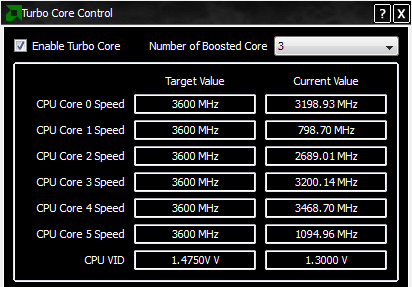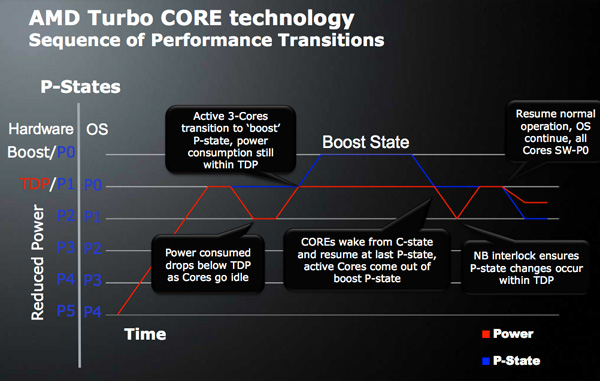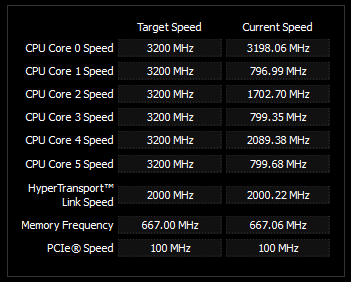AMD's Six-Core Phenom II X6 1090T & 1055T Reviewed
by Anand Lal Shimpi on April 27, 2010 12:26 AM EST- Posted in
- CPUs
- AMD
- Phenom II X6
AMD’s Turbo: It Works
In the Pentium 4 days Intel quickly discovered that there was a ceiling in terms of how much heat you could realistically dissipate in a standard desktop PC without resorting to more exotic cooling methods. Prior to the Pentium 4, desktop PCs saw generally rising TDPs for both CPUs and GPUs with little regard to maximum power consumption. It wasn’t until we started hitting physical limits of power consumption and heat dissipation that Intel (and AMD) imposed some limits.
High end desktop CPUs now spend their days bumping up against 125 - 140W limits. While mainstream CPUs are down at 65W. Mobile CPUs are generally below 35W. These TDP limits become a problem as you scale up clock speed or core count.
In homogenous multicore CPUs you’ve got a number of identical processor cores that together have to share the maximum TDP of the processor. If a single hypothetical 4GHz processor core hits 125W, then fitting two of them into the same TDP you have to run the cores at a lower clock speed. Say 3.6GHz. Want a quad-core version? Drop the clock speed again. Six cores? Now you’re probably down to 3.2GHz.
| Single Core | Dual Core | Quad Core | Hex Core |
 |
 |
 |
 |
 |
 |
 |
 |
This is fine if all of your applications are multithreaded and can use all available cores, but life is rarely so perfect. Instead you’ve got a mix of applications and workloads that’ll use anywhere from one to six cores. Browsing the web may only task one or two cores, gaming might use two or four and encoding a video can use all six. If you opt for a six core processor you get great encoding performance, but worse gaming and web browsing performance. Go for a dual core chip and you’ll run the simple things quickly, but suffer in encoding and gaming performance. There’s no winning.
With Nehalem, Intel introduced power gate transistors. Stick one of these in front of a supply voltage line to a core, turn it off and the entire core shuts off. In the past AMD and Intel only put gates in front of the clock signal going to a core (or blocks of a core), this would make sure the core remained inactive but it could still leak power - a problem that got worse with smaller transistor geometries. These power gate transistors however addressed both active and leakage power, an idle core could be almost completely shut off.
If you can take a single core out of the TDP equation, then with some extra logic (around 1M transistors on Nehalem) you can increase the frequency of the remaining cores until you run into TDP or other physical limitations. This is how Intel’s Turbo Boost technology works. Depending on how many cores are active and the amount of power they’re consuming a CPU with Intel’s Turbo Boost can run at up to some predefined frequency above its stock speed.

With Thuban, AMD introduces its own alternative called Turbo Core. The original Phenom processor had the ability to adjust the clock speed of each individual core. AMD disabled this functionality with the Phenom II to avoid some performance problems we ran into, but it’s back with Thuban.
If half (or more) of the CPU cores on a Thuban die are idle, Turbo Core does the following:
1) Decreases the clock speed of the idle cores down to as low as 800MHz.
2) Increases the voltage of all of the cores.
3) Increases the clock speed of the active cores up to 500MHz above their default clock speed.

The end result is the same as Intel’s Turbo Boost from a performance standpoint. Lightly threaded apps see a performance increase. Even heavily threaded workloads might have periods of time that are bound by the performance of a single thread - they benefit from AMD’s Turbo Core as well. In practice, Turbo Core appears to work. While I rarely saw the Phenom II X6 1090T hit 3.6GHz, I would see the occasional jump to 3.4GHz. As you can tell from the screenshot above, there's very little consistency between the cores and their operating frequencies - they all run as fast or as slow as they possibly can it seems.
| AMD's Turbo Core Benefit | |||||
| AMD Phenom II X6 1090T | Turbo Core Disabled | Turbo Core Enabled | Performance Increase | ||
| x264-HD 3.03 1st Pass | 71.4 fps | 74.5 fps | 4.3% | ||
| x264-HD 3.03 2nd Pass | 29.4 fps | 30.3 fps | 3.1% | ||
| Left 4 Dead | 117.3 fps | 127.2 fps | 8.4% | ||
| 7-zip Compression Test | 3069 KB/s | 3197 KB/s | 4.2% | ||
Turbo Core generally increased performance between 2 and 10% in our standard suite of tests. Given that the max clock speed increase on a Phenom II X6 1090T is 12.5%, that’s not a bad range of performance improvement. Intel’s CPUs stand to gain a bit more (and use less power) from turbo thanks to the fact that Lynnfield, Clarkdale, et al. will physically shut off idle cores rather than just underclock them.

I have noticed a few situations where performance in a benchmark was unexpectedly low with Turbo Core enabled. This could be an artifact of independent core clocking similar to what we saw in the Phenom days, however I saw no consistent issues in my time with the chip thus far.










168 Comments
View All Comments
mapesdhs - Tuesday, April 27, 2010 - link
Anand,
Thanks for the review! A good read overall, but a couple of niggles...
Why are there no i7 860 results in the results charts for 7-Zip, Batman, Dragon Age and Dawn
of War II? Likewise, why no 1055T data in the power consumption charts?
On the rendering tests page, you said this about the Cinebench test, where the 1090T does well:
"... if you've got a lot of CPU intensive threads there's no replacement for more cores."
But this is contradicted by the earlier comment for the 3dsmax test:
"Not all heavily threaded workloads will show the Phenom II X6 in a good light. Here Intel
maintains the advantage:"
Clearly, generalising here is unwise. For some reason, the Ph2 X6s lose out on the 3dsmax
test; but why? Lack of cache? Insufficient RAM bandwidth? Any ideas?
What kind of overclocking is possible with a good air cooler? Results with the stock cooler
are not really that interesting. I've bought a Thermalright U120E RevC to go with my 860.
Lastly, on the conclusions page, you say:
"Applications like video encoding and offline 3D rendering show the real strengths
of the Phenom II X6."
Not so, IMO. The i7 860 did better for the 3dsmax test (I'd really like to know why),
and although the 1090T was faster for the Cinebench multithreaded test, if you take
into account the higher power consumption of the 1090T, it offers a virtually identical
power/performance ratio under load. One of the reasons I chose an 860 system for
video encoding was because of concerns about power consumption; I had expected
the two extra cores in the 1090T would give a clear advantage in this respect, but it
doesn't (slower for the DivX test anyway, which is the encoding system I use, and a
worse power/performance ratio for the x264 2nd-pass test). In other words, where
the 1090T offers a speed edge, it's small (2 entire extra cores not really helping that
much at all), and its usefulness is negated by greater power consumption under load.
Hmm, can you confirm that all six cores in the 1090T were being used during the
DivX and 2nd-pass x264 tests? It just seems so odd to me that a 6-core chip isn't
doing better. I notice the scaling over the Ph2 X4 965 isn't that great here.
Btw, have you considered using V-ray as a render test? Studios using 3DSMax
often use V-ray as it scales to loads of cores AFAIK - I've been speccing out
32-core systems for a company in order to exploit this. Full details at vray.info.
Also, re pricing, the 1090T appears to be about 238 UKP in the UK (eg. scan.co.uk),
while the 860 is slightly less (234 from Scan), though after some shopping around I
was able to find the 860 for just 205. Clearly, if Intel is even remotely concerned about
the Ph2 X6, all they have to do is a minor price drop on Lynnfield to maintain a useful
price/performance edge.
Lastly, a word about BIOS support for these CPUs. Recently I've been scanning
eBay for AM2+/AM3 mbds, seeing what's available for a friend I'm helping out
with an upgrade; checking each board's specs, it's shocking just how many boards
have not received BIOS updates to support even the Phenom2 X4 and Athlon IIs,
never mind these new X6s. ASUS boards seem especially prone to this issue. So
watchout, always check the CPU support before buying. I'm still peeved that my
existing expensive M2N32 WS Pro can't use a Ph2 X4 (my gf's cheapo Asrock mbd
can). For this reason I went with an Asrock P55 Deluxe for my 860 build as Asrock
seem to be much more on the ball with BIOS updates.
If it were up to me, I would make it compulsory for vendors to include CPU support on
any board that has a theoretically compatible socket... :}
Ian.
PS. Perhaps a more concrete point to make is that the Ph2 x6s now definitely make the
i7 870 utterly pointless given its price (85% more expensive than the 860 for less than
5% higher clock).
Anand Lal Shimpi - Tuesday, April 27, 2010 - link
The 3dsmax test was an outlier if you look at the full set of results in Bench (www.anandtech.com/Bench). It could be a number of problems. Not all applications do well with core counts that aren't powers of 2 for starters. I don't believe we're memory bandwidth limited, but the 6MB L3 might have something to do with it.Like many benchmarks it's very difficult to keep 6 cores fully pegged. The x264 HD test ranges from 50 - 94% CPU utilization across all six cores on the Phenom II X6.
I haven't looked at vray as a benchmark, I'll do some digging :) And I agree completely on the issue of BIOS support. You should see how these things work behind the scenes, motherboard manufacturers are often still fixing BIOS issues on brand new boards even days before a launch like this.
Take care,
Anand
mapesdhs - Tuesday, April 27, 2010 - link
Anand writes:
> The 3dsmax test was an outlier if you look at the full set of results in Bench
Have you tried other render tests such as Maya Mentalray, or Alias Render?
Note that I have a render benchmark which is extremely cache-friendly and scales to
hundreds of threads, might be useful for ruling out the cache as an issue:
http://www.sgidepot.co.uk/c-ray.html
> applications do well with core counts that aren't powers of 2 for starters. ...
Beats me why this should be. Threads are just threads afterall. If it's not scaling well
because it's not a power of 2 then something somewhere has been badly coded
or designed, either the 3dsmax renderer itself, or the chip in some way, or the OS.
Hard to tell I suppose.
> Like many benchmarks it's very difficult to keep 6 cores fully pegged. The x264 HD
> test ranges from 50 - 94% CPU utilization across all six cores on the Phenom II X6.
This confirms my conclusion then, the X6 doesn't offer anything significantly useful
over the 860 in some cases, including DivX encoding. Where it's faster than the 860,
the difference is too small to be useful given the higher power consumption, and in
some cases even on multithreaded loads it's actually slower. I started reading the
article fully expecting the 860 to be trounced for the DivX test; that it was actually
slower was a bit of a shock.
> I haven't looked at vray as a benchmark, I'll do some digging :) ...
The systems I've been speccing out include the SGI Altix XE 340, BOXX 10400, SGI
Altix UV 10, Dell R810, Dell R910, SGI Origin400, SGI Octane III, etc. ie. all dual or
quad socket i7 XEON, 48GB RAM, that sort of thing.
> And I agree completely on the issue of BIOS support. You should see how these things
> work behind the scenes, motherboard manufacturers are often still fixing BIOS issues on
> brand new boards even days before a launch like this.
I dread to think...
I don't know how the vendors are allowed to get away with it. Such policies force people to
ditch their older motherboards even when in theory said board could use a modern CPU.
My ASUS board *should* be able to use the X6, but instead it's stuck at the useless Phenom1.
Asrock's approach couldn't be more different; that they would bother to add Ph2 X4 support
to a board as cheap,old and quirky as the AM2NF3-VSTA is remarkable (socket AM2 with
AGP), though I suspect they won't add X6 support for this board.
Ian.
Jamahl - Tuesday, April 27, 2010 - link
Please take a look at some of the other reviews around the web (like hexus, tomshardware) and ask yourself if you are using benchmarks that massively favour intel.Drazick - Tuesday, April 27, 2010 - link
Wouldn't you say that today most application are highly optimized towards Intel processors?Jamahl - Tuesday, April 27, 2010 - link
Yes I would however intel seem to have hit the jackpot on AT.Just look at the rest of the reviews to see how far out of whack Anand's is with the majority.
Anand Lal Shimpi - Tuesday, April 27, 2010 - link
I don't believe our full results are out of whack with what others have posted. Heavily threaded apps favor the Phenom II X6 (3D rendering, video encoding, 7z compression benchmark), lightly threaded or mixed workloads favor Lynnfield (gaming, everything else). It's more a question of what sort of balance do you strike between these applications. That's why I culled down the results for the actual review so we have a more balanced representation of all of the different potential scenarios.Take care,
Anand
Scali - Thursday, April 29, 2010 - link
What I noticed is that a lot of sites didn't include the i7 860, but only the considerably more expensive, but barely faster 870.I'm glad you used the 860, as it is pretty much in the 1090T's pricerange.
And as your tests show, most of the time the 860 comes out on top... while also having lower power consumption.
kwm - Tuesday, April 27, 2010 - link
I AM AN IT STUDENT AND USE A LOT OF VIRTUALIZATION IN LABS, VIRTUAL PC, HYPERVISOR AND SO FOURTH. WHAT I WOULD REALLY LIKE TO SEE IS A VIRTULIZATION COMPARRISION AND BENCHMARK. WE ARE MOVING SLOWLY IN THAT DIRECTION ANYWAY.LoneWolf15 - Tuesday, April 27, 2010 - link
You must have been gone on the first day of IT class when they explained that typing in allcaps is bad netiquette.